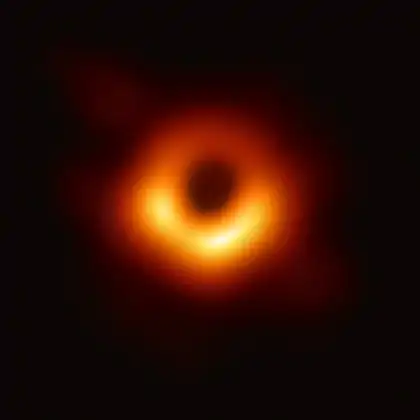Planck particle
A Planck particle, or planckion,[1] named after physicist Max Planck, is a hypothetical particle defined as a tiny black hole whose Compton wavelength is equal to its Schwarzschild radius.[2] Its mass is thus approximately the Planck mass, and its Compton wavelength and Schwarzschild radius are about the Planck length.[3] They play a role in some models of the evolution of the universe during the Planck epoch.[4]
Compared to a proton, for example, the Planck particle would be extremely small (its radius being equal to the Planck length, which is about 10−20 times the proton's radius) and massive (the Planck mass being 1019 times the proton's mass).[5] The Planck particle would also have a very fleeting existence, evaporating due to Hawking radiation after approximately 5×10−39 seconds.
Derivation
While opinions vary as to its proper definition, the most common definition of a Planck particle is a particle whose Compton wavelength is equal to its Schwarzschild radius. This sets the relationship:
Thus making the mass of such a particle:
This mass will be times as large as the Planck mass, making a Planck particle 1.772 times as massive as the Planck unit mass.
Its radius will be the Compton wavelength:
The Planck length ℓP is defined as
Dimensions
Using the above derivations we can substitute the universal constants h, G, and c, and determine physical values for the particle's mass and radius. Assuming this radius represents a sphere of uniform density, we can further determine the particle's volume and density.
| Parameter | Dimension | Expression | Value in SI units | Value in Planck units |
|---|---|---|---|---|
| Mass | M | 3.85763×10−8 kg | 1.7724 | |
| Radius | L | 5.72947×10−35 m | 3.5449 | |
| Maximum charge | Q | 2.86474×10−18 C | 1.7724 | |
| Volume | L3 | 7.87827×10−103 m3 | 186.6137 | |
| Lifetime | T | 4.826512×10−39 s | 89524.9652 [6] |
References
- H. J., Treder (1985). "The planckions as largest elementary particles and as smallest test bodies" (PDF). Foundations of Physics. Springer. 15 (2): 161–166. Bibcode:1985FoPh...15..161T. doi:10.1007/BF00735287. S2CID 121960540.
- Michel M. Deza; Elena Deza. Encyclopedia of Distances. Springer; 1 June 2009. ISBN 978-3-642-00233-5. p. 433.
- Hoyle, F. (1993). "Light element synthesis in Planck fireballs". Astrophysics and Space Science. 198 (2): 177–193. doi:10.1007/BF00644753. S2CID 121245869.
- Harrison, Edward Robert (2000), Cosmology: the science of the universe, Cambridge University Press, ISBN 978-0-521-66148-5 p. 424
- Harrison 2000, p. 478.
- i.e. 5.5683 times longer than a hypothetical black hole of 1 of mass
External links
- Sachs, R.; Narlikar, J. V.; Hoyle, F. (1996). "The quasi-steady state cosmology: Analytical solutions of field equations and their relationship to observations". Astronomy and Astrophysics. 313: 703. Bibcode:1996A&A...313..703S.
- "Mach's principle: from Newton's bucket to quantum gravity" – Google Books
- "Mysteries of Mass: Some Contrarian Views From an Experimenter"
- "The Gauge Hierarchy Problem and Planck Oscillators" – CERN Document Server
- "The First Turbulence and First Fossil Turbulence"
- "Lecture on Nuclear Physics for Plasma Engineers"
- The Planck Length

